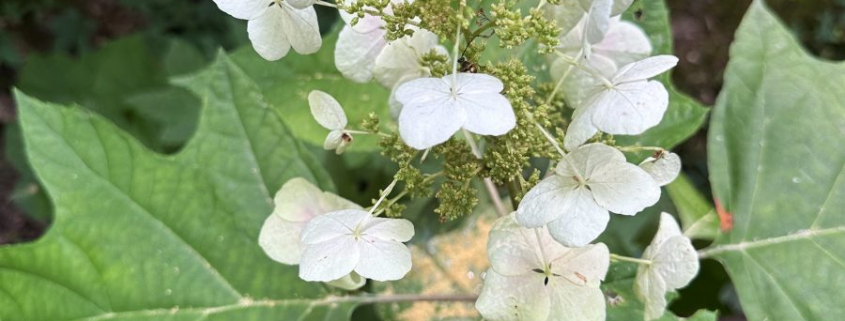Miscellaneous Treasures from a June 2023 Visit to the Belcher Addition at Oak Mountain State Park!
Fellow retired forester Chris Stuhlinger and I arrived at Oak Mountain State Park on schedule at 9:00 AM June 8, 2023, intent upon touring the 1,600-acre Belcher property addition, visiting historic Camp Tranquility, and orienting Chris to hazard tree control measures at the Park. I focus this Post on the miscellaneous Nature treasures we encountered while touring the Belcher property.
I remind you that June 8 preceded my cardiologist-imposed stress test by a week. I was not the least bit concerned. After all, I am a former marathon runner with a superb heart! Boy, was I in for a shock…but that’s a longer tale that I have now chronicled elsewhere, including in some of these Posts.
Plant Observations
Longleaf pine occupies some of the Belcher upland, in this image standing above an understory of sourwood, one of my favorite subordinate canopy species in our northern Alabama forests.
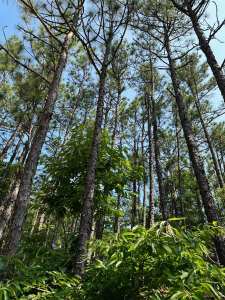
Sourwood honey is renowned for its rich flavor and deep sweetness. Our patch was in full flower.
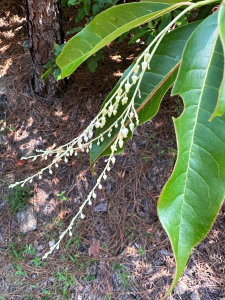
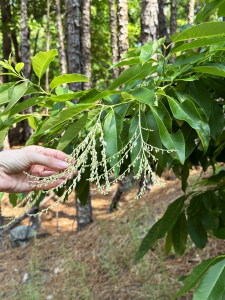
Nearby we encountered an intermediate canopy hickory sporting a grotesque burl, satisfying my long-time fascination with tree form curiosities and oddities. I wondered what triggered this rampant and seeming random growth. The tree’s fate is likely sealed, subject to breakage and structural failure.
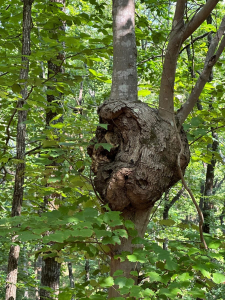
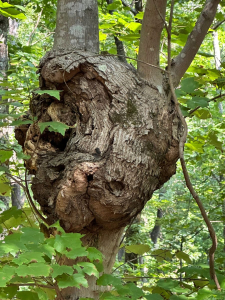
I don’t recall encountering a fly poison plant in prior ventures, much less a speciment in magnificent flower. An online Shenandoah National Park source provided detailed descriptive and narrative information:
Fly poison is a perennial plant with wide, grass-like basal leaves. Flowers are initially white in color but later becoming green or red. The 3-petaled flowers (plus 3 sepals) are clustered in a dense raceme on top of a 1-3 foot tall leafless stalk. Fly poison is one of the first herbaceous species to emerge in early spring. It is typically found in dry to moist woods, meadows, and open fields. It is common throughout the Eastern United States, from New York south to Florida and as far west as Oklahoma and Missouri. Although all parts of the plant contain toxins, the bulbs are the most toxic. The Cherokee used the plant topically to stop itching. They also used the root to poison crows. Exploiting the bulb’s toxicity, early American settlers ground the bulb into a paste and mixed it with sugar or honey to attract and kill flies.
We saw only this single specimen. What good fortune to find both sourwood and fly poison blooming.
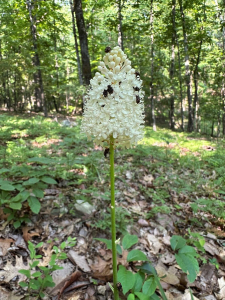
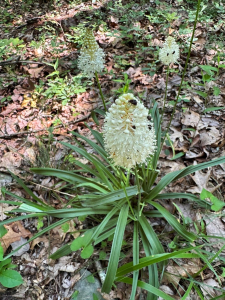
We were likewise fortunate to find both white (bottle brush) buckeye and oakleaf hydrangea in flower.
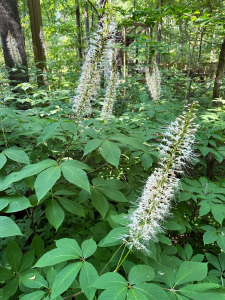
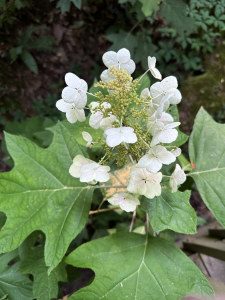
An NC State University online source describes sparkleberry, our next find, as:
a small, deciduous to evergreen shrub or tree that may grow 10 to 20 feet tall. It can be found in rocky woodlands, sandy woodlands, and on cliffs. The leaves are alternate with a smooth or finely toothed margin. The bark is shredded and patchy with reds, browns, and grays present. In early summer, small, white, bell-shaped flowers mature. In the fall, this plant has excellent color. The tall shrub produces a black fruit that matures in the fall and is a good food source for wildlife.
Vaccinium arboreum (also known as farkleberry) is the only tree form of the blueberry genus. Don’t you just love the whimsical moniker of sparkle/farkle-berry!?
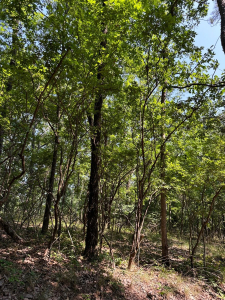
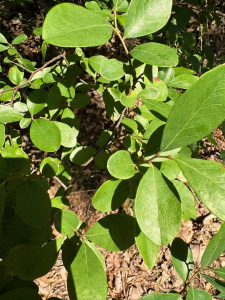
An online Missouri Department of Conservation source describes sensitive briar as:
a trailing or creeping perennial of dry areas, entirely covered by hooked barbs. Flowers in ball-shaped heads on long stalks arising from leaf axils; florets many, funnel-shaped, pink to rose-colored, with yellow-tipped stamens protruding. Blooms May–September. Leaves alternate, double-compound, with 13–15 primary divisions that are again divided into 8–16 tiny leaflets (called pinnules). These small leaflets are sensitive to touch and can fold and close like those of the related mimosa tree. Fruit a slender, very prickly pod to 3½ inches long, splitting lengthwise into four parts when mature.
Sensitive briar is a species of Mimosa. Interestingly, our very own invasive mimosa tree (Persian silk tree) is not a member of the Mimosa genus! However, the sweetbriar leaf looks very much like the Persian silk tree foliage. How’s that for serving to confuse us Nature enthusiasts?
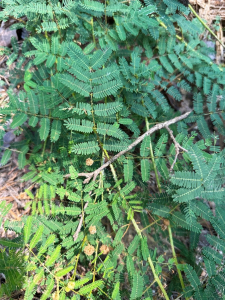
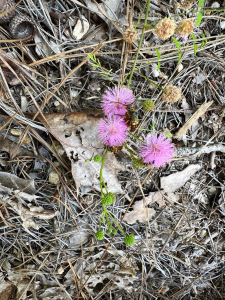
Our incredible longleaf pine forests, which covered 92 million southeastern US acres at European settlement, begins life in appearance as a wanna-be tree, spending as many as 3-7 years in what we foresters term its “grass stage.”
An online Longleaf Alliance resource describes this early stage:
This unique stage of a longleaf pine’s life history resembles a clump of grass more than a tree, hence the name “grass stage.” The young trees will not grow in height; instead, grass stage longleaf focus their growth underground to develop an impressive root system. During the grass stage, a thick cluster of needles protects the growing tip (bud) while the tree remains at ground level. If a fire occurs, the needles may burn but the tip of the bud remains protected. New needles quickly replace those that were burned off. During the grass stage, longleaf pine seedlings are very resistant to fire damage. The grass stage may last anywhere from one to seven years depending on the degree of competition with other plants for resources. Rare instances of 20 years have been documented.
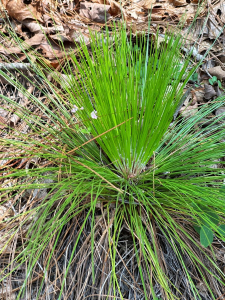
Nature’s ways are complex, but her mysteries are never without cause. Five hundred years ago, da Vinci observed:
There is no result in nature without a cause; understand the cause and you will have no need of the experiment.
I admit to remaining to this day about uncertain in distinguishing between poison oak (left) and fragrant sumac (right). Side by side, no problem (below), yet when I am out and about and see one, I simply elect to avoid touching either! We positively identified poison oak on the Belcher tract. The fragrant sumac photo I borrowed from a previous hike elsewhere.
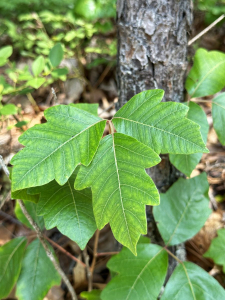
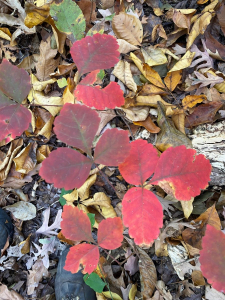
Our Belcher plant explorations occured by chance and I offer the portfolio in no particular order.
Wildlife Observations
I’ll shift from the plant to the animal kingdom. Near the picnic shelter at Lake Demopolis, I inquired about the bankside burrows, located just 100 feet from the shoreline. I had no clue. Our Park Naturalist hosts, without hesitation, informed us that these are nesting burrows for resident belted kingfishers! An Audubon.org website notes:
The best places to see Belted Kingfishers are along sandy banks, where they are busy digging nesting burrows. These stocky, short-legged birds use their front claws—with two forward-pointing toes fused together for added strength—and their strong bills to dig holes. The holes typically reach three to six feet into the sandy bank, but some nesting holes can extend 15 feet.
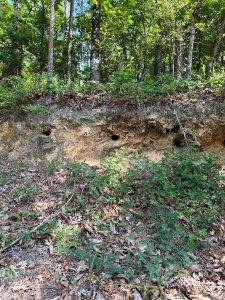
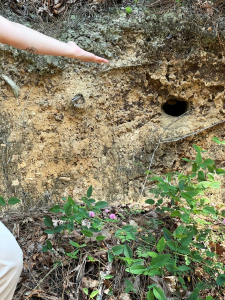
Now I know the source of these burrows, another lesson learned from a pleasant day exploring the Belcher addition to Oak Mountain State Park.
As we departed Belcher Lake, ascending the road on its west shore, we rose eye-to-eye with a great blue heron perched ~25 above the water level. The bird tolerated us long enough to capture several images.
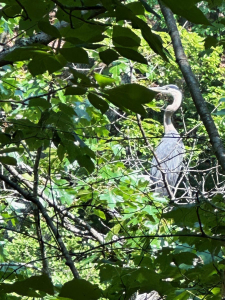
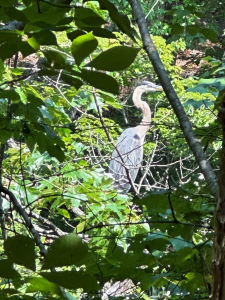
Another curiosity caught our attention — a geometrically-patterned collection of bream beds. What are bream? The online FisheriesBlog.com offers a partial description:
Bream vs. sunfish. In the US, bream (pronounced brim) is a common name that encompasses several of the larger Lepomis sunfishes. These usually include Bluegill and Redear Sunfish. Anglers often call the same species different names based on their life forms: large colorful males can be called bream, while smaller individuals of the same species are dismissed as perch, sun perch, or some other misnomer. This is particularly common in the Southern US, where many state management agencies manage all sunfish with the same regulations as simply bream.
The distinction is rich with local lore and accepted practice. Now, what are bream beds? Okay, I’ll give you my take. Bream females use the power of their tails to clear a small area of pond bottom on which to lay eggs, often doing so in aggregations of five to a hundred or more…all the better for watchful and protective males to guard the area from egg and fry predators.
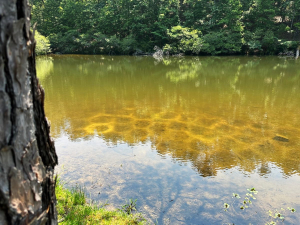
I recorded this 0:21 bream bed video along the shoreline of Belcher Lake.
We completed our 2-3 hour orientation of the Belcher addition without wandering more than a few hundred feet from the road, a necessity given our goal of achieving multiple objectives on our single day visit. We accept every encountered treasure as a gift. I’m especially grateful for what amounted to my last Great Blue Heron Nature sauntering prior to emergency triple bypass surgery. I’m completing this narrative on August 17, 2023, a little more than eight weeks since surgery. My return to the woods is iminent…and I am thrilled!
Alabama State Parks Foundation
Thoughts and Reflections
I offer these observations:
- Nature rewards even a 2-3 hour roadside exploration with multiple treasures.
- There is no result in nature without a cause; understand the cause and you will have no need of the experiment. (Leonardo da Vinci)
- In every walk with Nature one receives far more than he seeks. (Muir)
Inhale and absorb Nature’s elixir. May Nature Inspire, Inform, and Reward you!
Note: All blog post images created & photographed by Stephen B. Jones unless otherwise noted. Please circulate images with photo credit: “©2023 Steve Jones, Great Blue Heron LLC. All Rights Reserved.”
Another Note: If you came to this post via a Facebook posting or by an another route, please sign up now (no cost… no obligation) to receive my Blog Post email alerts: http://eepurl.com/cKLJdL
And a Third: I am available for Nature-Inspired Speaking, Writing, and Consulting — contact me at steve.jones.0524@gmail.com
Reminder of my Personal and Professional Purpose, Passion, and Cause
If only more of us viewed our precious environment through the filters I employ. If only my mission and vision could be multiplied untold orders of magnitude:
Mission: Employ writing and speaking to educate, inspire, and enable readers and listeners to understand, appreciate, and enjoy Nature… and accept and practice Earth Stewardship.
Vision:
- People of all ages will pay greater attention to and engage more regularly with Nature… and will accept and practice informed and responsible Earth Stewardship.
- They will see their relationship to our natural world with new eyes… and will understand more clearly their Earth home.
Tagline/Motto: Steve (Great Blue Heron) encourages and seeks a better tomorrow through Nature-Inspired Living!
Steve’s Three Books
I wrote my books Nature Based Leadership (2016), Nature-Inspired Learning and Leading (2017), and Weaned Seals and Snowy Summits: Stories of Passion for Place and Everyday Nature (2019; co-authored with Dr. Jennifer Wilhoit) to encourage all citizens to recognize and appreciate that every lesson for living, learning, serving, and leading is either written indelibly in or is powerfully inspired by Nature.
I began writing books and Posts for several reasons:
- I love hiking and exploring in Nature
- I see images I want to (and do) capture with my trusty iPhone camera
- I enjoy explaining those images — an educator at heart
- I don’t play golf!
- I actually do love writing — it’s the hobby I never needed when my career consumed me
- Judy suggested my writing is in large measure my legacy to our two kids, our five grand kids, and all the unborn generations beyond
- And finally, perhaps my books and Blogs could reach beyond family and touch a few other lives… sow some seeds for the future


All three of my books (Nature Based Leadership; Nature-Inspired Learning and Leading; Weaned Seals and Snowy Summits) present compilations of personal experiences expressing my (and co-author Dr. Wilhoit for Weaned Seals and Snowy Summits) deep passion for Nature. All three books offer observations and reflections on my relationship to the natural world… and the broader implications for society. Order any and all from your local indie bookstore, or find them on IndieBound or other online sources such as Amazon and LifeRich.

